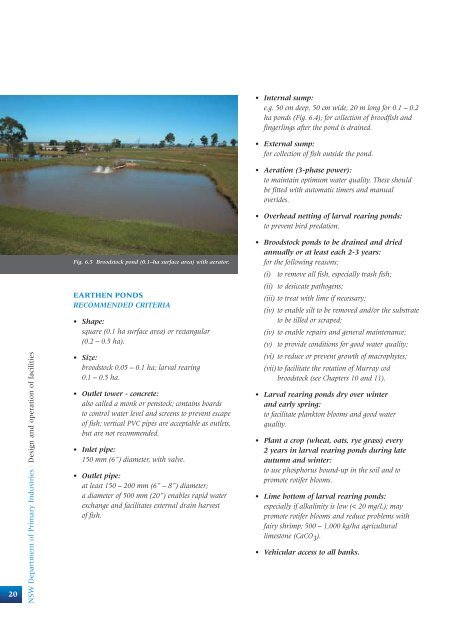Hatchery Quality Assurance Program - NSW Department of Primary ...
Hatchery Quality Assurance Program - NSW Department of Primary ...
Hatchery Quality Assurance Program - NSW Department of Primary ...
Create successful ePaper yourself
Turn your PDF publications into a flip-book with our unique Google optimized e-Paper software.
• Internal sump:<br />
e.g. 50 cm deep, 50 cm wide, 20 m long for 0.1 – 0.2<br />
ha ponds (Fig. 6.4); for collection <strong>of</strong> broodfish and<br />
fingerlings after the pond is drained.<br />
• External sump:<br />
for collection <strong>of</strong> fish outside the pond.<br />
• Aeration (3-phase power):<br />
to maintain optimum water quality. These should<br />
be fitted with automatic timers and manual<br />
overides.<br />
• Overhead netting <strong>of</strong> larval rearing ponds:<br />
to prevent bird predation.<br />
Fig. 6.5 Broodstock pond (0.1–ha surface area) with aerator.<br />
• Broodstock ponds to be drained and dried<br />
annually or at least each 2-3 years:<br />
for the following reasons;<br />
(i) to remove all fish, especially trash fish;<br />
(ii) to desiccate pathogens;<br />
(iii) to treat with lime if necessary;<br />
(iv) to enable silt to be removed and/or the substrate<br />
to be tilled or scraped;<br />
(iv) to enable repairs and general maintenance;<br />
(v) to provide conditions for good water quality;<br />
(vi) to reduce or prevent growth <strong>of</strong> macrophytes;<br />
(vii) to facilitate the rotation <strong>of</strong> Murray cod<br />
broodstock (see Chapters 10 and 11).<br />
20<br />
<strong>NSW</strong> <strong>Department</strong> <strong>of</strong> <strong>Primary</strong> Industries | Design and operation <strong>of</strong> facilities<br />
EARTHEN PONDS<br />
RECOMMENDED CRITERIA<br />
• Shape:<br />
square (0.1 ha surface area) or rectangular<br />
(0.2 – 0.5 ha).<br />
• Size:<br />
broodstock 0.05 – 0.1 ha; larval rearing<br />
0.1 – 0.5 ha.<br />
• Outlet tower - concrete:<br />
also called a monk or penstock; contains boards<br />
to control water level and screens to prevent escape<br />
<strong>of</strong> fish; vertical PVC pipes are acceptable as outlets,<br />
but are not recommended.<br />
• Inlet pipe:<br />
150 mm (6”) diameter, with valve.<br />
• Outlet pipe:<br />
at least 150 – 200 mm (6” – 8”) diameter;<br />
a diameter <strong>of</strong> 500 mm (20”) enables rapid water<br />
exchange and facilitates external drain harvest<br />
<strong>of</strong> fish.<br />
• Larval rearing ponds dry over winter<br />
and early spring:<br />
to facilitate plankton blooms and good water<br />
quality.<br />
• Plant a crop (wheat, oats, rye grass) every<br />
2 years in larval rearing ponds during late<br />
autumn and winter:<br />
to use phosphorus bound-up in the soil and to<br />
promote rotifer blooms.<br />
• Lime bottom <strong>of</strong> larval rearing ponds:<br />
especially if alkalinity is low (< 20 mg/L); may<br />
promote rotifer blooms and reduce problems with<br />
fairy shrimp; 500 – 1,000 kg/ha agricultural<br />
limestone (CaCO 3 ).<br />
• Vehicular access to all banks.

















